Hybrid pepper "Buratino" for lovers of sweet and juicy high-yielding varieties
Many gardeners believe that it is possible to grow a full crop of peppers only in the southern regions. However, the selection does not stand still: dozens of varieties and hybrids adapted to cool climates. In the article, we will consider one of these crops - a hybrid of Buratino sweet bell pepper.
The content of the article
What is this pepper
Buratino is a high-yielding early hybrid, perfectly adapted to temperate latitudes... Large-fruited peppers are appreciated for their taste, they look colorful in winter preparations. Caring for the culture will not be difficult.
Feature and Description
The hybrid is resistant to the most common nightshade diseases. Tolerates heat, rainy weather, lack of light. It is grown in a greenhouse and open field. The best harvest is in temperate latitudes.
Semi-determinant plant (reaches 1 m in height). The bushes are weakly branched (2-3 shoots), but they look sprawling. The leaves are small, dark green.
reference! Semi-determinant cultures stop growing at a certain point, are limited in growth. Their main advantage is early maturity.
Hybrid F1
If in the southern latitudes there are no problems with cultivation, then in the middle lane the F1 must have specific qualities:
- the ability to grow outdoors;
- ease of care;
- fast ripening;
- unpretentiousness to weather conditions.
Buratino meets these requirements.
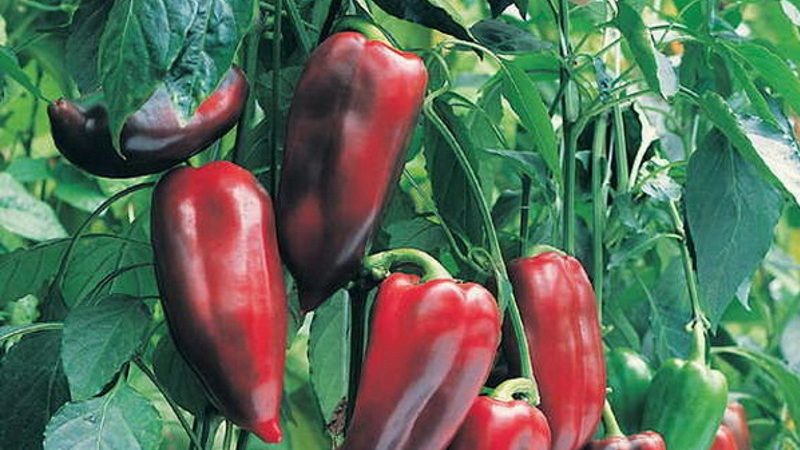
Distinctive features
Hybrid Pinocchio pepper has a number of features:
- good germination;
- resistance to tobacco mosaic, top rot;
- long-term fruiting and storage;
- drought resistance;
- the ability to grow in shaded areas.
Characteristics of fruits, yield
Ripe fruits are red, large (about 17 cm long and 8 cm wide), cone-shaped, slightly ribbed. Each weighs 100–120 g, the walls are 4–5 mm thick, and the skin is dense.
Peppers are juicy, sweetish, stored for a long time. The sugar content in them is 3.9%. The yield is high: up to 13 kg per 1 m2.
Preparation for growing
Sowing for seedlings begins in February - March. Use light soil with good drainage or ready-made soil mixture. At home, mix peat, sand and earth in equal parts and add humus.
The largest seeds are chosen without cracks. When placed in brine, they will sink to the bottom.
Planting material processing methods:
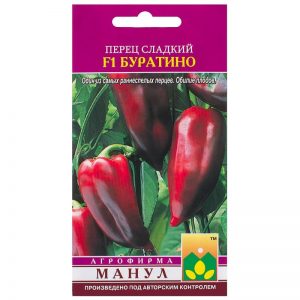
- place in warm water (no more than +50 ° C) for 4 hours, wrap in a damp cloth and keep for several days;
- hold in a solution of potassium permanganate for 20 minutes;
- place in 40% hydrogen peroxide solution for 10 minutes, do not rinse, dry;
- treat with growth stimulants: "Epin", "Zircon" and others;
- hold in ash solution to raise the immunity of future sprouts;
- put in the refrigerator for 1 week, then for 1 day - in a mixture of water and aloe juice.
Important! When soaking the seeds, do not allow them to be completely immersed in the liquid.
Seed germination is up to 70%.
Growing seedlings
Seedlings, as they germinate first in a common container, and then dive, and immediately plant them in separate containers.
With a dive
The seeds are planted in boxes and covered. Soil temperature - +15 ° C. The emerging seedlings are provided with good lighting and regular ventilation. They constantly monitor soil moisture.The film is removed after 14 days and mineral fertilizers are applied.
Important! Seedlings are additionally illuminated with phytolamps, since there is not enough natural sunlight for the plants at this time of the year.
After the appearance of 2 pairs of real leaves, a pick is carried out. The seedlings are moved into cups, preferably peat ones. The temperature in the room is maintained within the range of + 25 ... + 27 ° C, but not lower than +20 ° C. On the eve of planting in the ground, the culture is gradually taken out into the street, strengthening its adaptation to new conditions.
Without picking
This growing method is less traumatic for the delicate roots of the peppers. 2 seeds are immediately placed in separate cups. One of the sprouts (weaker) is subsequently removed. After the appearance of 4 true leaves, the plants are transferred to large pots.
Planting pepper
Disembarkation on a permanent place begins in the last days of April, in warm weather, in the afternoon. The distance between the holes is 35-40 cm, between the rows - 50 cm. A handful of humus and ash are placed in the holes. Density landing - 7 bushes per 1 m2.
Buratino has a weak root system: the hybrid is planted in places protected from gusts of wind, as the plants can break.
Attention! It is a self-pollinating hybrid: it is not planted next to other varieties of peppers to avoid carrying pollen from them.
Further care
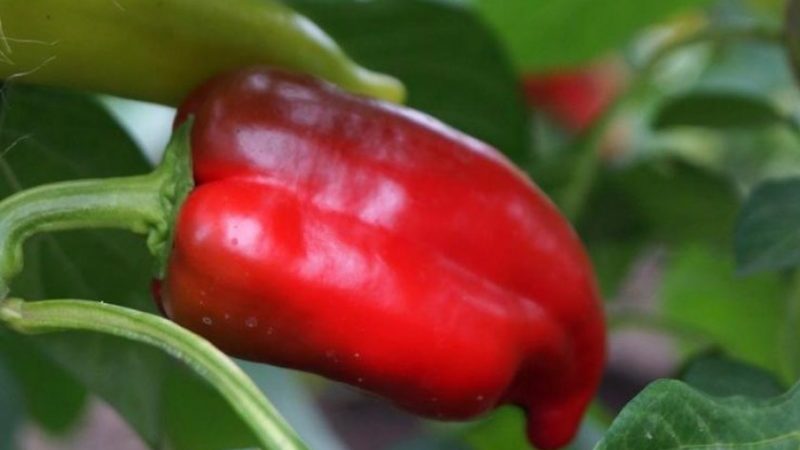
After picking seedlings into open ground or a greenhouse, the following activities are periodically carried out:
- Loosening the soil: the roots need to breathe.
- Watering for the first time is carried out daily, and when the plants get stronger, they are reduced to 2 times a week. Use warm water.
- Fertilizer. In total, 3 dressings are applied: the first - after planting, the second - during the flowering period, the third - during fruiting. Use the infusion of dung, manure, ash, solutions of mineral fertilizers. When signs of wilting of plants appear, foliar feeding is performed on the leaf.
- Topping. They do this as needed: the bushes do not branch much, therefore they do not need to be formed. The crown flower is removed (formed in the center of the bush).
- Hilling. Carried out for the growth of the root system.
Features of growing varieties and possible difficulties
When growing Pinocchio, it is important to consider its features:
- peppers bear fruit on the 90th day after sowing, in the greenhouse - on the 80th;
- in protected ground the yield is higher;
- in the southern regions, crops are grown in open ground, in the middle lane - in greenhouses.
There are no particular difficulties in care compared to other varieties.
Typical diseases and pests
The hybrid is moderately resistant to tobacco mosaic and top rot. With proper agricultural technology, the culture is not affected by other diseases.
Insect pests that threaten peppers:
- Aphid - affects all leaves and flowers. Control measures: treatment with rapidly decomposing insecticides ("Keltan", "Karbofos") at the rate of: 1 tbsp. l. preparation for 10 liters of water. For prevention purposes, the funds are used before and after flowering bushes. During the fruiting period, chemicals are not used.
- Spider mite - feeds on plant juice. Bushes die in a short time. Control measures: treatment with acaricides of the bushes themselves and the soil under it. They use special sticks that are buried in the ground. During watering, they dissolve, the poison goes into the soil and enters the plant itself. Suitable for these purposes are "Plant-Pin", "Etisso", "Substral", "Green house-dust".
Possible illness:
- Verticillosis... Signs: withered or twisted leaves with brown or yellow spots. Defeat can only occur on one branch. The fungus penetrates the roots and spreads throughout the plant. Control measures: treatment of bushes and soil with fungicides ("Vitaros", "Previkur", "Fundazol", "Topsin M", "Maxim").
- Alternaria. The reason is the constant temperature drop. The main features are: dark brown angular spots on the leaves, water stains on the fruits and a small fluff on the stems. The fungus attacks the inside of the peppers.The disease progresses in dry weather. Control measures: treatment of bushes with a solution of Bordeaux liquid at the rate of: 100 g of the drug per bucket of water.
Advantages and disadvantages of a hybrid
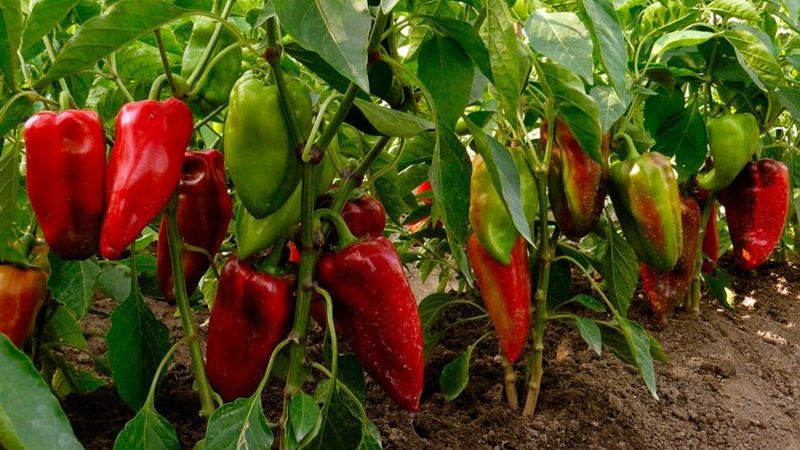
Buratino F1 advantages:
- high productivity;
- large fruits;
- unpretentious care;
- early ripening;
- disease resistance;
- high content of vitamin C (204.5 mg per 100 g);
- suitability for conservation;
- long shelf life (ripe fruits at a temperature of +2 ° C and humidity of 90% retain their taste and presentation for 60–90 days);
- bushes do not require molding.
Disadvantages:
- sometimes a garter is required;
- the inability to use their own seeds, as it is a hybrid.
Reviews
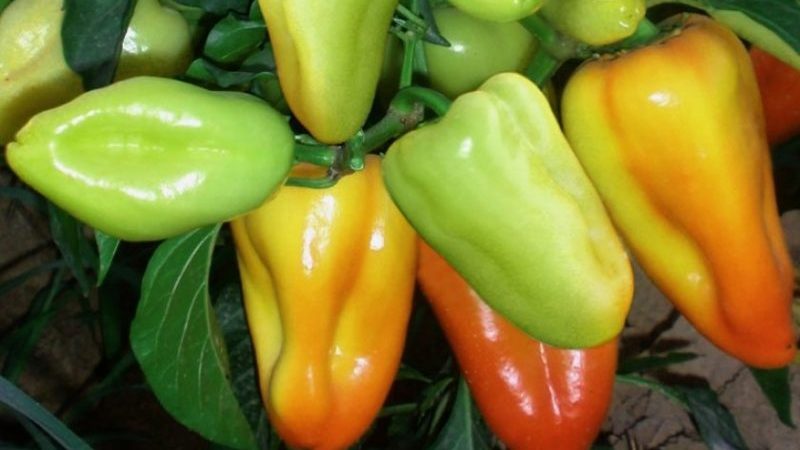
Vegetable growers share their impressions, observations and experience of growing a hybrid:
Valentina, Voronezh: “I have been growing this pepper in a greenhouse for the second year. To increase yields, I advise you to pluck peppers at the stage of technological maturity, that is, green. So you free the bushes, and they have the strength to form new fruits. "
Mikhail, Moscow region: “Buratino grows better in a greenhouse. The harvest is stable and good. I noticed that if you remove the crown flower, then fruiting slows down. So I leave him. "
Marina, Leningrad region: “I have been growing Buratino for several years in a row. The bushes are always large, the stems are finger-thick. The year before last, heavy rain bent the bushes, some even broke. Since then I decided to tie it up, even if the bushes are not tall. The peppers are bright, as in the photo, very tasty both fresh and canned... The aroma is fragrant, I like to add vegetables to salads. I like it even in a state of technical maturity. "
Ivan, Lipetsk: “Out of inexperience, I made a mistake, and my peppers were pollinated with a bitter variety. I advise you not to grow different peppers within the same area. "
Conclusion
The Pinocchio hybrid is suitable for growing in temperate regions. Despite its thermophilicity, it tolerates temperature extremes, rains and lack of moisture well, while maintaining a high yield (up to 13 kg per 1 m2) and decent fruit quality.
The culture will appeal to both homeowners and those who cultivate vegetables on an industrial scale.